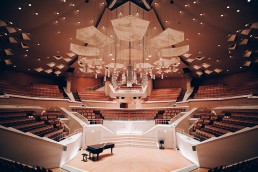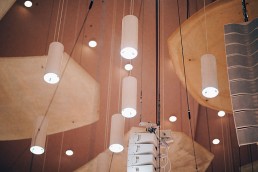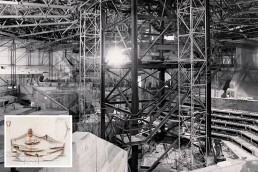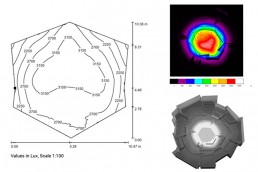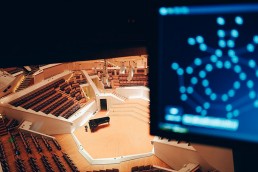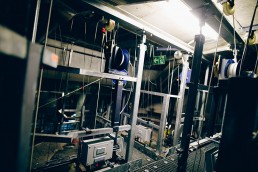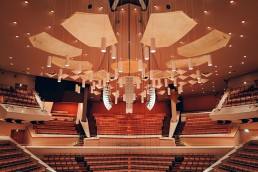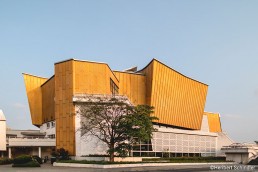This website uses cookies so that we can provide you with the best user experience possible. Cookie information is stored in your browser and performs functions such as recognising you when you return to our website and helping our team to understand which sections of the website you find most interesting and useful.
Philharmonie Berlin
ProjectPhilharmonie BerlinLocationBerlin, GermanyManufacturers GDS, UK / ETC, USDistributorVisionTwo GmbH, GermanyLighting DesignerGDS, IBMInstallerAmptown System Company GmbHSubmitted by VisionTwo GmbH, Germany
Ever since 1963 the Philharmonie Berlin has been the capital’s musical heart – at the opening when it was still located at the periphery of West Berlin, and even more so when it became part of the new urban centre after the reunification of Germany. Today the Philharmonie designed by Hans Scharoun belongs to the Kulturforum Berlin along with the chamber music hall, the museum of musical instruments and a series of other buildings and is just steps away from the Potsdamer Platz. Its exceptional design reminiscent of the shape of a tent and the conspicuous yellow colour visible from afar have made it one of the city’s landmarks. While initially the unusual and innovative character of its architecture and concert hall design provoked controversy, the Berliner Philharmonie has since inspired architects of concert houses everywhere in the world.
The chamber music hall completed in 1987 seating an audience of 1,180 is the “little brother” of the Berliner Philharmonie – in terms of both the architecture and the range of musical events. With its tent-like design and the concert platform positioned at the centre the conceptual idea which defines the “big” Philharmonie is repeated.
As is frequent practice in cultural buildings, conventional 120V / 250W light bulbs with E27 thread were used in the chamber music hall as well. However due to new EU energy directives this type of bulb is no longer produced, and as the Philharmonie’s supplies were becoming scarce an alternative had to be found that would come up to the highest demands the philharmonic orchestra or any other orchestra playing in the chamber music hall might have with regard to lighting. Upon winning the contract, ASC involved Anke Schierenbeck from VisionTwo, the Berlin planning office IBM and the manufacturer GDS in the job of developing various light simulations for the 50 lights which were awaiting replacement. A series of lighting tests was performed under real conditions as well in order to convince the user of the level of enhancement that could be achieved if the new lighting equipment was used.
After sampling had been successfully completed, the ArcSystem “Pro One-Cell High Output” type with 108W, 8,000lm, a constant colour temperature of 3,000K and D1HO DMX RDM driver was identified as the equipment of choice. The particular challenge consisted in mechanically fitting the LED heat sink to the existing cylindrical housing and in providing a secure structural connection of steel ropes and existing cables to ensure mechanically reliable pendant mounting above the orchestra. “These problems could be solved in the ASC workshop where we had the chance of availing ourselves of Christian Schroeder’s long-standing construction and development experience”, Anke Schierenbeck points out. Thus, structural details were generated in the 3D printer, lasered metal parts ordered, powder-coated at ASC’s and assembled as small-batch series during the summer break in a very short time.
Kai Mielisch, Technical Director of the Berliner Philharmonie, is happy that the house now benefits from a first-rate solution. “Considering the narrow time frame, I’m especially glad that despite this constraint VisionTwo was able to provide an adequate light equipment solution which even resulted in a major enhancement of the lighting situation in our house. The sampling procedures and the light simulations helped us to make the right decision.”
With the DMX network being extended additional cables and their support systems had to be installed as well along with the switch boxes for the electronic control equipment. The ArcSystem Pro One-Cell High Output LEDs are operated with one D1HO DMX RDM driver each which means that the LEDs can be dimmed down to 0% in an absolutely smooth process and that it was not necessary to replace the winches used in the hall for pendant mounting and control of the lights. ArcSystem has long been established as the industry standard auditorium lighting system for theatre and opera houses having initially been designed by UK company GDS and becoming an ETC product range in August 2019.
“To find LED lights able to accentuate the uniqueness of our house – in this case of the chamber music hall – was not easy in itself”, says Robert Eberle, lighting director. “From a technical point of view, it took top priority however that the new solution would allow for perfect dimming and come up to the technical standard I and the orchestra expected the lighting to meet. As a matter of fact, the brightness of the orchestra lighting has been multiplied, and I hear no complaints any longer that someone is unable to read their sheet of notes. Indeed with the lights from the ArcSystem series VisionTwo and ASC have done an excellent job!”
We consider it a part of our responsibility to preserve the unique styles of the various eras by involving rather than neglecting existing parts of buildings.
With sustainability an issue of exceptional relevance especially in these fast-moving times it is extremely important to integrate efficient, state-of-the-art technical equipment into existing structures. To translate this aim into reality, innovative planners, resourceful manufacturers and distributors, smart integrators with craftsmanship and ingenuity are needed who are highly committed to working out individual solutions for each client. By expertly integrating modern, high-performance LED lights into existing housings which date back to the sixties, and by installing the drivers at the original positions of the winches so that no replacement was required we have preserved a piece of architectural history together and at the same time provided the orchestra with the brightness it needs.
By competing for and possibly receiving the award we are hoping to make people aware of how important it is to preserve existing structures because it is the task of us all to act keeping sustainability in mind.
Xxx
